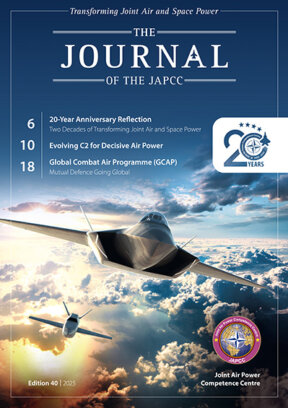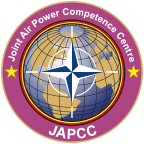Welcome to the 40th edition of the JAPCC Journal. As we continue to mark our 20th Anniversary this year, we are taking the unique opportunity not only to reflect on two decades of progress in Alliance Air and Space Power, but more importantly, to look ahead to the challenges and opportunities on the horizon. This edition, therefore, explores the critical adaptations NATO must embrace to deter and defend for decades to come.
I’m excited about the articles in this edition, where we directly confront the need to evolve our thinking, technology, and structures. You will find this theme explored through the lens of strategic foresight in our article on Wargaming, a critical tool for testing and refining future concepts and force design. We also examine the intellectual core of modern warfare with a fresh look at Digitized Targeting and the imperative of Evolving C2 for Decisive Air Power, where guest authors recommend how to best orchestrate effects across all domains to prevail.
This adaptation is driven by a blend of technology and integration. Several articles tackle the disruptive capabilities shaping the modern battlespace. We offer an operator’s perspective on the immense potential and practical challenges of Hypersonics, and examine the transformative role of Artificial Intelligence in enhancing the training of our air battle managers.
Our front page and main article are dedicated to the first of three inside stories about the major sixth generation fighter programmes within NATO and Allied countries. Here we begin to look ahead to the next generation of air power, with a contribution from the Global Combat Air Programme (GCAP).
Yet technology alone is not enough. As John Boyd used to say: ‘People, Ideas, and Hardware, in that order.’ Success depends on our ability to integrate these capabilities together. Our article on Space-Centred Leadership addresses the unique traits our Space leaders will need to succeed in this important domain. We then focus on ongoing advancements of NATO’s Air-Land Integration, and we’ve also considered the full spectrum of warfare, from revitalizing NATO’s Personnel Recovery mission, to strengthening our Civil-Military Cooperation in the Cyber Domain. Finally, we ground these future-focused discussions on the realities of today. An analysis of Electronic Warfare Challenges in the Russia-Ukraine War provides lessons for the Alliance.
I am proud of the work our JAPCC team and guest authors have invested in this edition to provide an intellectual foundation for the Alliance. These discussions will continue at our upcoming Joint Air and Space Power Conference, where we look forward to engaging with you in person. We hope you find this collection of articles both thought-provoking and useful, and we always invite your feedback at .
Vito Cracas
Colonel, ITA AF
Assistant Director, JAPCC








